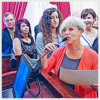Robert Olsen
Vilano Beach
Special to Historic City News
Looking back at the St Augustine Airport, it’s hard to imagine that the airport was closed for several years after serving a military function during World War II. It was reopened in 1955 and has grown to become a hugely important regional asset — much more than a place to land an airplane. Few other 668-acres in Florida have as intense a concentration of high-paying jobs and economic activity.
A master planning initiative, just getting underway and funded by a $768,253 grant from the Federal Aviation Administration, is addressing some important questions that affect the future of Northeast Florida Regional Airport.
- How can the airport accommodate growth opportunities for commercial airline service?
- How might the airport become an even stronger catalyst for regional economic development?
- What are the costs and financial strategies to take the airport to the next level, both operationally and physically?
A dominant presence at the airport is defense contractor Northrup Grumman, where some 1,200 workers are mainly engaged in producing the Navy’s Hawkeye E-2D; an aircraft at the pinnacle of America’s advanced military arsenal. This latest version of the Hawkeye is unequaled as an airborne surveillance, command and control center. In February, a squadron of E-2Ds deployed to Japan to support U.S. security interests in the Western Pacific.
The newest addition has been commercial airline service. A 2005 airport master plan paved the way by identifying airline market potential and outlining a plan for infrastructure improvements needed to make it happen. Soon the first airlines began testing the market for scheduled service into St. Augustine. Current carriers, Via Air and Frontier, boarded most of the 27,000 passengers who flew out in 2016. Frontier’s service is still seasonal, with non-stop flights to Philadelphia resuming on April 21.
The convenience and low cost of commercial service in and out of St. Augustine makes everyone hopeful for more flights and destinations coming soon. The airport’s 2005 master plan projected as many as 14 daily flights by 2023, accounting for 111,000 boarding passengers. To support this level of service, the airport would require land for a 698-car parking lot.
It is evident that the airport is running out of land. This can be seen by anyone trying to find the airport’s shiny new passenger terminal — it is hiding behind several large maintenance hangars. Fortunately, a series of signs have been installed to direct drivers along a chain link fence and through a series of turns to reach a drop-off entrance and parking area. Unlike other airports, don’t expect to see much formal landscaping — there is simply no room for it.
Past airport studies have struggled with the issue of a landlocked site impeding operational improvements and opportunities for growth in general aviation, commercial air service and industry support. Plans for expanding the airport’s footprint go back to the 1995 airport master plan, which recognized that expansion was only feasible to the west. It proposed relocating a stretch of US-1 and FEC railroad further west of their current alignments, for a gain of over 1,000 acres. This expansion required an estimated capital outlay as high as $186 million. The airport’s governing body, the St. Augustine – St. Johns County Airport Authority, has considered this expansion scenario to be unrealistic from a cost standpoint, even though the authority has since initiated some land acquisitions in the area where the planned SR-313 joins US-1.
The master planning now underway will take a new look how NFRA might best serve St. Johns County and beyond in the years to come, including costs, benefits and strategies to fund improvements. Airports typically undertake major expansions with a combination of bond financing, FAA grants and operating revenues. Airports are also hoping to be part of a national infrastructure initiative now receiving bipartisan enthusiasm in Congress.
The voters of St. Johns County have given the airport authority the ability to levy up to .5 mills annually for airport development and operations. Based upon the county’s latest valuation, this generates approximately $10.5 million annually. Bond financing even part of this stream could create the capital for transformational improvements.
The authority has worked to avoid tapping any of its voter-approved taxing power in recent years. It has, instead, funded incremental facility improvements and airport upgrades with grants and available operating funds. However, as the new round of planning for the airport’s future proceeds, a most important issue will be: Is now the time to act in a bigger and more visionary way to fully unlock the potential of our landlocked airport?
Robert Olson is a retired architect, urban planner, and former senior official of the U.S. Department of Commerce. He resides on Vilano Beach.
Discover more from HISTORIC CITY NEWS
Subscribe to get the latest posts sent to your email.




